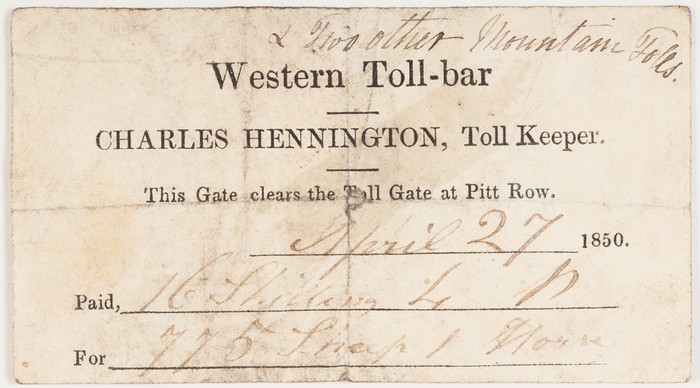Western Toll Bar receipt
27 April 1850
Printed ephemera
Bequest of Sir William Dixson, 1952
DN / P 709
Receipts such as this allowed the bearer to pass through toll gates erected on a number of Sydney’s roads. In this case, the receipt was for travel through the toll gate located on the Western Road (now the Great Western Highway) at Pitt Row in Parramatta. While we don’t know the name of the person to whom the receipt was issued, we know the toll-keeper was Charles Hennington. He is most likely the convict Charles Hennington, who arrived in 1823 on the ship Ocean.
Hennington had been sentenced to transportation for life in 1822. The NSW Government Gazette of 21 March 1838 records that Charles Hennington received his Ticket of Leave (a form of parole), and was, at the time, living in Parramatta. He received his Conditional Pardon on 1 July 1846, and by 1850 it seems was gainfully employed.
A vision splendid
In the early years of the colony, roads were vitally important economically and for the maintenance of public order. Governor Arthur Phillip’s vision for the fledging settlement included streets that were ‘placed so as to admit a free circulation of air, and are two hundred feet wide’.* But his vision failed to eventuate, and the earliest roads simply followed the natural contours of the land or the tracks used by the Aboriginal people.
With the expansion of the settlement to Rose Hill, later to be renamed Parramatta, the need to transport food and goods into and around the settlement resulted in several road developments. The road to Parramatta was laid out around 1797 and was remade several times in the ensuing years. As farming land was opened up to the west and northwest of Sydney Cove, and settlements established on the Hawkesbury River, further roads were established, including the Windsor Road.
When Governor Macquarie took office in 1810, he set out to impose some order on the streets, with a grid established on the southern, eastern and western sides of the growing township. Accessible and reliable roads inland were also required, and Macquarie made extensive use of private contractors to build these roads. In May 1810, James Harrex was contracted to build a toll road from Sydney through Parramatta to the Hawkesbury River. In 1813, William Roberts, an emancipated convict, was contracted to build a road from Sydney to Liverpool, and by 1814 a road from Liverpool to the Western Road near Parramatta was in progress. Macquarie also had a road built east to South Head using military and convict labour.
To pay the private contractors who had built the roads, toll gates were set-up at the points were the road entered the town. As the town expanded, the toll gates were moved further out. These toll gates marked the ‘gateways’ to Sydney. Toll bars also permitted some scrutiny over the movement of people around the settlement and often the movement of stolen goods and stock was detected.
Footnotes
* Arthur Phillip to Lord Sydney, 9 July 1788, Historical Records of Australia



 Back to list
Back to list